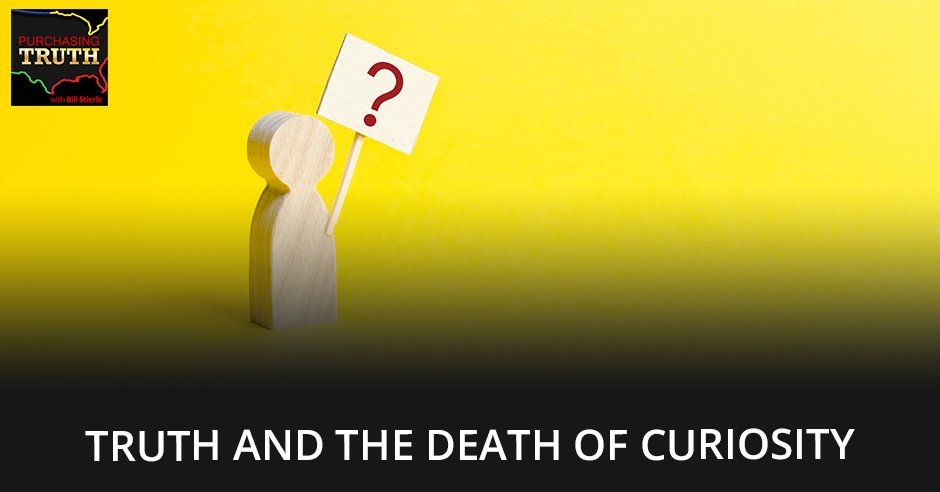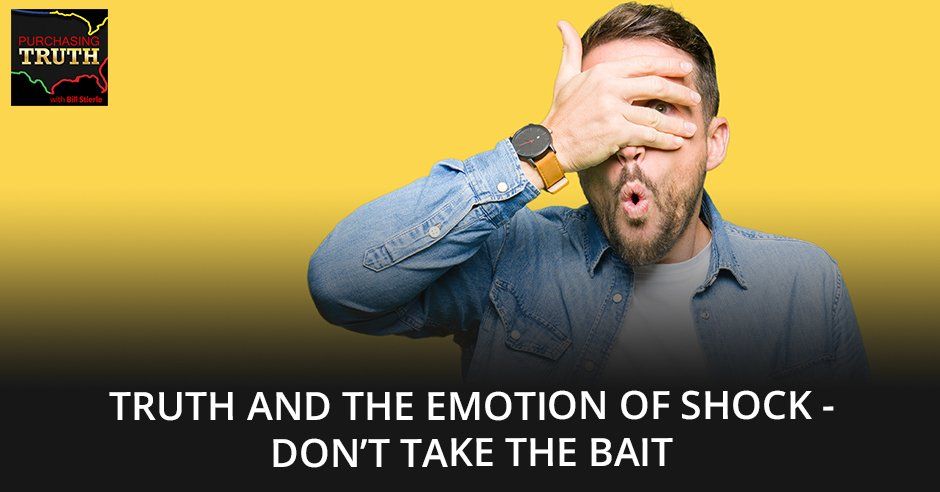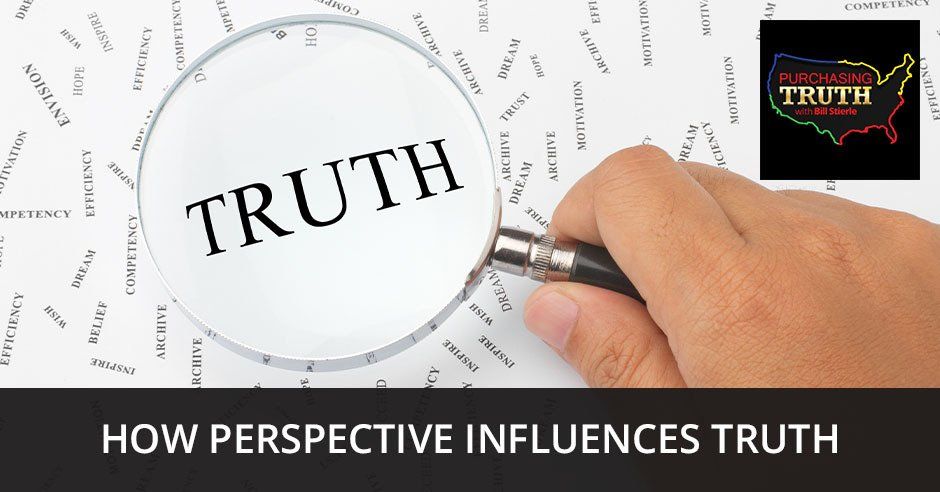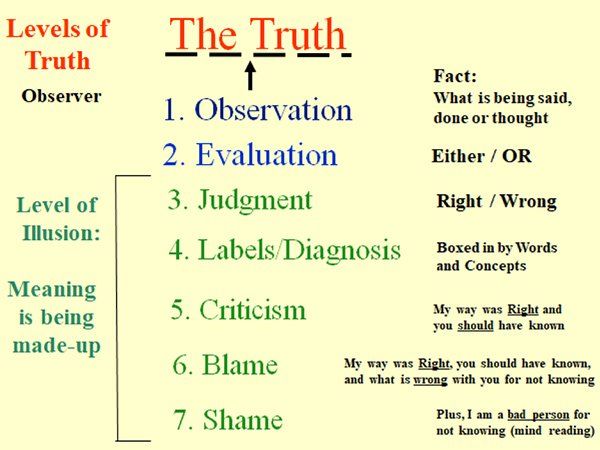How Perspective Influences Truth
Subscribe Today!
It is a fact that Americans are allowing the truth to be purchased which can be best exemplified by the everyday labels intensely paraded by big corporations and political characters. In this premiere episode of Purchasing Truth, hosts Bill Stierle and Tom talk about the problems with perspective and how much it influences truth. Join Bill and Tom’s powerful conversation about meeting the need for truth and understanding why our viewpoint has so much value in influencing it. They also get down on the importance of perception and perspective and shed some light on the societal effects of blaming, shaming, labels, and diagnoses.
---
Watch the episode here
In this episode, we’re going to be talking about the problems with perspective and why a person’s viewpoint has so much value to it, but it also influences truth. That’s pretty interesting.
It’s very interesting, especially in the context of what’s been happening in our society, especially in our politics since about 2015.
Don’t you think, Bill?
One of the biggest challenges is that as soon as we start talking about the relationship we have as human beings with the word truth, we start to see that there are some important language distinctions that we need to make when we’re talking about what truth is. Where in the past, there was a very much a leaning towards if you’re saying the truth, at least you’re advocating for some form or some version of what a fact might be. Since 2015, I remember the first time or the thereabouts when the term fake news started becoming popular. What happened was like, “What’s the difference between true news and fake news? How do we have an honest discussion about which one’s which?
It seems that fake news is one of those things that can make my blood boil at times when somebody labels something fake news. They throw it around so easily and then it seems so many people believe it, even if it’s true news.
The challenge that we’re into is how do you have a safe conversation about versions of truth, what a person’s viewpoint or opinion is and where that is on the scale of truth. A big part of this show is to get a sense of how can we move forward? How can we discuss things in a safe way and say, “This is the truth that I’m advocating for, but I’m willing and open to see what truth you’re working on over there?” That is a very different narrative because that’s the way out versus advocacy on trying to score points. Instead, I’m going to be stable about it and have a good discussion about truth.
I am one of those people that have always thought that truth was absolute. I thought, “Some of these are either true or it isn’t,” but it’s not that way, is it?
No. The truth does change. It does evolve. We do research. We find out new things all the time and the line for truth moves. The only challenge with that particular reality is that what was true for somebody ten, fifteen, twenty years ago is not very true now and not necessarily what the person’s experience is. They might have formulated a completely different set of truths or beliefs. They have a range of different ways that they’re mixing truth together with facts and things that are beliefs. It gets wiggled very quickly.
In some ways, it is eye-opening and in some ways, it’s disappointing but it is a reality. When I hear somebody say, “Truth isn’t the truth,” I was like, “You’ve got to be kidding me,” but maybe that is true.
Truth is not truth necessarily. There’s a thing called a truth perspective in which we’re going to look at. What is the truth perspective? What is your viewpoint of truth? We see if the whole thing is good or the whole thing is bad? Are you talking about a small little fly on an apple pie? Are you focusing on, “That fly landed on the corner of the apple pie, therefore, I’m not going to believe the whole apple pie?” This whole belief structure is going to go in alignment with that and that gets unsettling really quick because people think that differently.
Unless I didn’t see the fly on the apple pie and my truth is the apple pie is fine.
It’s fine. It wasn’t that big of a deal. I shooed it away. That was a small little thought thing I had. I didn’t do that thing because it was small. It was minuscule. It didn’t mean anything. That’s called minimalization. I’m going to take whatever the person said or did and say, “Yes, that’s what it was in the field of time. I’m accountable for it, yet I’m in big trouble here to try to explain my way out of this.” There is a way out, though. That’s the whole part of this show. There is a way out of this mess that we’re in. There’s a languaging way out. We’re going to start getting into what is the languaging and the way out to have a better discussion between what the thing that’s leaning towards the word fake, what is leaning towards the thing called true and get those things apart from each other.
I hope there’s a way out, Bill. It’s been shocking and frustrating and disappointing, speaking for myself personally, with all the obvious lies in our political reality now more than ever before. The number we’ve seen is something 10,000 lies that the president has said in his first couple of years in office. How do we get through that? How do we get to a place where honesty and integrity mean something?
They have to move more towards the front of the list versus some of this other language and narrative. You’re hearing it more now in media controlling the narrative and establishing the narrative. What does the word narrative mean? It’s establishing a story on your version of the truth. That’s what I’m doing. I’m establishing a story. I want to be the first out. I want to get the heart news cycle. I want to imprint as many brains as possible so I can occupy that space. People don’t have time. They perceive. They don’t have time to listen again and question and say, “That might not be so good there. That is not so good.” The whole point of the legal system is to slow down and do investigation and research into what people said or did. What was their frame of mind and what was their intention?
Unconscious people do all things that are junky. You still go to jail for stuff like that, even if you’re unconscious or naive or whatever, “Officer, I was driving along in the car. I was in the back seat. What could I have done?” The answer is to get out of the car before the bank robbery. That’s what the logical mind would say, but there are a lot of other things that go in with like getting trapped in the back seat of the car. We’re going to see if we could get ourselves out of the back seat of the car and get ourselves into the front seat of the car. Would you like to see how that can be done?
I would love to see how it can be done. It does feel though like it’s very hard to trust the news, doesn’t it?
Trust is now showing up. There are two feelings that go with truth and trust. Truth, when that button gets pushed, usually doubt shows up. I feel doubtful. My need for truth isn’t met. Trust is a little different. I feel skeptical about trust. You see that the emotions are different. What happens is that if I start pushing both of the buttons at the same time, truth and trust, the person is walking around in a state of doubt and skepticism. People get overwhelmed with all the other things that are happening in their life and then throw their hands up in the air and go like, “I don’t know but I voted for this guy. I’m going to stick with that vote.” That means you’re not even checking in with it.
I needed to do something around the word truth. I said, “I can’t take it anymore.” What is the way to do something about it? First, truth is trying to figure out where it is and what it says. This little chart I came up with is called The Levels of Truth. I got these things called levels. First, we know that we want to get to and start to engage truth in a different way. We want to get closer to the truth as the best way we can. That means that there’s going to be a series of concepts that are going to start close to the truth and move further away from the truth. The first and the closest space to be, it doesn’t mean that it’s exactly right on target, but it’s the closest to truth you can be is the position called observation.
Observation has a relationship with truth because it’s something I can see. It’s something I can hear. It might even be a thought I have about something. When somebody says something, I hear you say this sentence. I watch you do this action. I’m guessing you have this thought that’s called premeditation. That’s a thought and a lot of times they’re saying, “This person was premeditated to do the bank robbery because here are the interior specs of the bank vault. The chances of them having thoughts about it before means that it was premeditated.” “I had thought about the thought and then I took action.” “We caught you before you made the bank thing. We intercepted. We interrogated somebody and they said you were planning this thing.”
You could see that there’s a relationship between observation and thought. These things can be true, but it doesn’t mean it’s fully true because I could be looking at something but I might not be seeing it. My point of view might not be showing this. On the internet, there’s a picture of somebody giving somebody else the finger. The point of view is the person was just waving. On the other side, it looks like the person was shooting a bird at them. There it is right there. Is that true? It depends on your point of view. That’s the person observing.
Certainly, observation and its relationship to truth make a lot of sense. It is very helpful to understand your perspective can still skew the truth.
It still can. With that said, let’s say you and I are looking at a wall that’s painted. It was painted yellow. You and I are standing a couple of feet from the wall and I say, “Tom, that wall’s yellow.” You’ll look at it and say, “I hear that you’re calling it yellow, but I think it is Glidden paint. It’s called Desert Sunset.” “Tom, I’m calling it yellow.” You’re giving me, “No, Bill. I know what that actual paint color is. This is the truth.” Your evaluation is coming with some presumed expertise that you know something about paint. I called it yellow. You called it Glidden Desert Sunset.
You’re oversimplifying it and I’m getting more detailed, but they are different degrees of truth. Is that what we’re saying?
That’s right. There are different degrees of truth. I’m right with yellow. I’m in the right family group but accuracy-wise, you’re closer. These are the two positions that are closer to the truth until you get to position number three. It’s going to move a little further away. “It’s not Glidden. It’s Behr. It’s called Bahamas Sunrise. That’s the kind of yellow it is.” “It’s not Desert Sunset?” “No, it’s Bahama Sunrise. I got the swatch for it.” “You’re observing this. We’re evaluating it, but I have the definitive thing.” “Really? You have the definitive thing?” “Yes, I do. I’m an expert. I have been painting for years. People know me as the expert of paint.” I am the expert. I’m owning the label and I’m diagnosing myself as an expert in paint. In fact, I have a PhD in paint.
I didn’t know you could get a PhD in paint.
I would imagine you can. I don’t know either, but you could see that instead of looking at our own eyes, we’ll give weight to an expert. “That person’s a congressman. What job did they have before they were congressmen? They worked and they own this business.” “Did they study law because that’s what congressmen are supposed to do is create laws.” “No, they were a truck driver and they were big in the community. People got to know them and they made it through there. Now, they are congressmen.” That’s a label. That is an identity. We’re going to wait and give because that person has communicated the message that we would like to see or hear. They’re going to validate our truth about what can be done or what is the best for the country.
This is how we got to where we are. You can see that. All you’ve got to think about is any diagnosis or decision that was made. Those other people, whether it’s Christians or Muslims or Jewish or whatever distinction you’d like to stick with them, all of a sudden, the label is diagnosis as well. There are different ways to approach the truth. I happened to go down the truth regarding religion. The truth regarding politics as well, there are Democrats, there are Republicans. What does that mean? They’re independent. You can see the truth is not fully cooked. We’re forced to step away from the truth. Where do you stand on health care? As soon as you step into that position, everybody else gets to take a shot at you.
This is where you get the label of, “You’re a socialist.”
That’s right. It’s not fully the truth. We’re not even using the word definition. We’re sticking somebody in a box. Things are not going well for us as you may notice, especially when we go, “The way you’re thinking isn’t right and my way is right. You should know better.” You could see how a criticism of one group or another can come back around. Didn’t we talk about we can’t run up the debt? We ran up the debt. What has been hijacked is the truth about what the initial argument was because I am already in this identity. I am now wiggled over here and then my truth, my thing inside the box is huge. I can see it up. My way is right.
This is the way the truth is. What happens is that different people might be closer to what the fact is. It might be closest to what the person’s done or what the person thought or motive is. We need to expand our language and be a little more specific to say what true news looks like. We’re closer to this truth at this point in time. We’re moving away from that truth that was talked about in the past. This is a new truth that we’re experiencing. I’m giving talking points to newscasters because they don’t necessarily know how to navigate the ambiguity of truth.
I see that a lot in the news where newscasters are doing a lot of what they called “fact-checking.” They try to combat somebody else’s truth with what they believe are the facts and it doesn’t seem very effective.
A fact will never beat an illusion. There’s no doubt about that. A fact can’t penetrate because there’s only one position for a fact to occupy. You’re close to the truth. Meanwhile, we’ve got all this language sitting on top of it that is skewing what the person can hear and experience and go through. Their perception and perspective as being shifted. Once criticism shows up, the next level that gets us away from truth is a blaming type narrative. That’s what shows up next. The way blame works are, “My way was right. You should have known. What’s wrong with you for not knowing?” We’ve got some big trouble. It doesn’t matter what the person has set up. We’re still arguing between four, five and six up.
Four, five, and six degrees separated from truth. Is that what we would say?
That’s right. We’re actually away from the truth. We’re arguing on the illusion part of this equation. The seventh part is that when we start collapsing down, then it’s a shaming narrative. “It’s a shame. I’m a bad person.” “I should have known. How could I have not known? They should be ashamed of themselves.” “Ashamed of themselves? No way.” They’re advocating their label and their diagnosis. “There’s no shame there. I’m just saying this thing,” but I’m creating a disconnection or an illusion to show up. Instead of being in the observer position, what I’m doing is I’m creating all these different meanings. I’m making up a meaning for the story.
Whether it’s a newsperson that’s trying to create a story or a story of engagement, what they’re missing is that it doesn’t help us either. It doesn’t help us get your version of your belief or of your speculation. It doesn’t help us get closer to the truth. What helps us get closer to the truth is the ability to speak in observation, get used to dropping the language of judgment and criticism, and do some scary honesty with the integrity of, “You are doing the best you could to win,” not to talk about what this focus is.
Unfortunately, it has become the new normal. We hear on a daily basis from the White House this criticism and shame. A lot of, “That’s a disgrace what that person said or that person’s a disgrace.” Often times, months ago when they were in the President’s favor, they were one of the best people. Now, what they’ve done is now a disgrace. We seem to be so far from the truth in so many ways. One of the things I struggle with, Bill, is what do I tell my children who are seeing these things on the news? We raised them to be honest and truthful. We coached them that it is what you should be. Yet, here we have full-grown adults that are at the forefront of our society clearly lying or getting further away from the truth. I struggle with this.
What do we tell our children? How do we instruct? How do we provide a perspective? We want to keep our language closer to observation and closer to evaluation. It might sound like, “This is what this person says.” I feel doubtful. It doesn’t meet my need for truth. What my truth is this. There are still people that believe some of that truth, but most of the people are on this level of truth.
We’re trying to teach our children perception and perspective. What are you perceiving observation-wise? What’s your perspective? What is the meaning that you’re making out of it? Then, we give them a boast message. For example, if something on the news or one of the politicians or even the President says something, I might say, “I feel irritated. It doesn’t meet my need for kindness to talk about somebody like that. It doesn’t meet my need for respect or mutual respect that they’re saying that.”
What I’m talking to my kid about is that I’m owning that this person crossed the line on one of the high values that I value in my family and the value inside myself. It doesn’t meet the need for respect for the country, when. It doesn’t meet the need for financial security, when. It doesn’t meet the need for fairness, when. This type of narrative is centered around an observational style versus who’s right. There are all kinds of different ways to spend money, but it doesn’t mean it’s the best way. It doesn’t mean it’s the way that we can’t take from where we are to where we need to go and it works better.
It seems like we’re off the rails in the United States.
Off the rails is a great label and diagnosis. You’re correct. The level of criticism and blame and shame is very high. We’re trying to drag it back to right or wrong. What happens is for different people, all you got to do is listen to testimonial and stuff like that. You’ll hear people criticize an unrelated topic just to stay away from the right-wrong narrative. Do you see how that works? I’ll criticize something that’s tangential or something that has happened in the past. I’ll try to go back to that to reinvigorate that old pain. Meanwhile, the thing they were arguing about was three years ago, five years ago or seven years ago. They’re down here.
Aren’t they trying to distract or misdirect from something that they are pretty far from the truth on?
Some of it is purposeful and most of it is, “This is what got me here and this is what brought me to the dance. I’m not going to let go of what brought me to the dance.” It’s my strategy of labeling my opponents and then criticizing them from that label. If you stick a label on somebody and you criticize them for the label, that’s going to give you a lot of power. Anybody that’s listening to that sees that person that I labeled as the ones to blame. Now, I’ve got a target.
You’ve planted this idea in everybody’s mind and they can’t think or see anything else.
They can’t think or see anything else. They can’t see that, “This is the label. This is criticism. This is who I’m to blame,” instead of finding out the motive about why somebody would call something about that. If somebody would call me, I’m going to go to observation. “Would you be willing to tell me what I said or did for you to call me that label that you just did?” That definitely turns it around. Now, I’m empowered with their derogatory label. I’m dragging their butt with compassion all the way back up to the front of the list. It’s like, “I’m willing to explore the truth that your perspective pushed in my direction. I’m going to push it in my direction. Let’s go ahead and take this out for a spin and please tell me what I said or did.” “I don’t know. You’re just.” “You have a thought than I am just?” “Yes.” “Tell me what I said or did other than your thought.” “All Democrats, all Republicans.” “You have a thought, but not me specifically. You have a thought that a Republican or Democrat, they all think alike. Is that what your thought is?” “No.” “Tell me what I said or did.”
Bill, this is so enlightening. You’re demonstrating how you can defend yourself, but also turn the tables and go on offense when somebody labels and diagnosis you. It seems that no one was able to do that against Donald Trump in his primary challenge. All the labels he threw out Little Marco, Lyin’ Ted, Crooked Hillary. This is his mojo.
The shadow side is you stick a label that’s not true then keep broadcasting until it burns into people’s brains. The way that corporations do, what they’re trying to do is they’re trying to get their brand to occupy a space in your brain. They’re trying to literally paste it on. When you think of cereal, you think what?
Probably Cheerios.
Cheerios wins the branding war in Tom’s brain. See how weird this is? How about gasoline? What gasoline do you think?
I think of Costco.
That’s good. That brand has occupied because you have that value consciousness. You fill up your tanks there for $0.10, $0.20, $0.30 less a gallon than everybody else pays.
Here in California, it’s been $0.50 less a gallon lately.
I had no idea. Now, I’m feeling a lot better about my Costco card. You can see that all of a sudden, the brand occupies. Crooked Hillary occupies as a brand. Meanwhile she’s got this resume and all these different people that she’s met in the government. What better resume to run the job than that resume? You could say that there are problems with her as a person and whatever character assassination or her belief structure for. That’s problematic because we’re still not looking at what the issue is and what the person’s beliefs are from an observational place. It’s not me advocating for Hillary or advocating for or being against Trump. It’s you and me taking a look at how truth gets purchased through these languaging tactics.
It seems like no one, so far, in the political sphere has been well-equipped with the techniques, the language, the knowledge to be able to prevent those labels and diagnoses, blaming and shaming from hijacking their truth.
They’re not aware that they have to create their own label and their own brand identity in order to stand up to his brand identity.
To help drag him back up, as you were saying.
To drag him back up to have a truthful discussion about what does fairness looks like instead of, “Here’s how I played by the rules that were broken to my own advantage.”
Observation has a relationship with truth because it's something we can see and hear.
CLICK TO TWEET
If they come back and start throwing facts at him, they’ve lost.
You can’t do that. You have to draw his tactic out because his tactic is a shame tactic, a blame tactic. He spends a lot of times, four, five and four, five and six mostly and then he calls the other people wrong because he’s framed the story and framed the narrative from four or five and six.
Bill, this seems like such a mess that we’re in.
It is such a mess. That’s a good label. It is messy unless we take it one sentence at a time. We’ve got to take it one sentence at a time. Mess means we have a need for order. Mess means that we have in need of integrity. Mess means we have a need for truth that needs to be told in a better way. Mess means we need to have a better sentence to truth to power, truth to responsibility and identity. Clearly, if somebody has elected us to be a congressman, it doesn’t mean automatically that we have the wisdom and knowledge and experience to execute the job. The founders didn’t make it that you have to have a degree in political science or a law degree to be a congressman or a senator.
You just have to get elected.
The idea is we want a diversity of voices. We don’t want all the people who know how to manipulate the law. You don’t want all those folks in charge. We want to have at least somewhat of the common people’s voice in there somewhere, but it’d be nice if they knew how to do it. The second part of that, which is the ethical problem, is they have this knowledge about what they’re supposed to be doing in their job. Then be in touch with what their constituents want, not the few constituents that are paying them, but the multitudes of constituents that voted for them and get them to be in the game fully.
That’s closer to where the observation is. I’m not judging. I know how we got here, but the challenge is we’ve got to walk our way back closer to observation. What did the person say? What did the person do? What were the person’s thoughts? Tell me what your thoughts are and let’s have a discussion. I have this thought in this way. Tell me how your thought has been formulated. Look at how that takes a little bit of extra time. Labels and diagnoses are easy. Stick a label on a printer and stick it on a coffee cup and you got it. The label is on there. “I know exactly what’s in that jar.” No, you don’t. You see or just reading the label.
You can stick it on a red hat too.
You could stick the label on a red hat. If that label is a little easier to say or think about or to believe, are we going to be an inclusive nation or are we going to make America great again by separating each other and call one group bad and wrong and the other person right? Is that what we’re doing next? It’s a little more second world, a little more third world country-ish than first world country. First-world is let’s get in an honest discussion about what is the best practice. We’re not even close to best practice.
We’re nowhere in the vicinity now.
We’re in blame and shame criticism land. That’s where we are right now. It’s tough.
It seems there is a way to turn the tables.
To turn the tables is staring down the illusion of the meaning that’s being made up and realize that it’s that these last five constructs. We can back ourselves off a shaming narrative gently by going, “Where is the target? Who is the person that’s saying the thing? Here’s where the criticism lies, what we should have known and shouldn’t. Where did the labeling and diagnosis start? Who got put in what box? Is it right or wrong that we put them in that box?” The answer is no. Not if we want to be having inclusion and have a healthy conversation, it doesn’t. “How do we evaluate what our choices are moving forward?” Did you feel your body lift and become more optimistic as I started getting rid of the crap? That’s weird and all I’m doing is adjusting the slide show to take off blaming and take off shaming and take off blaming, take off criticism, take off the label and diagnosis, take it off.
What we’re left with is an evaluation of, “How can you balance fiscal responsibility with the general stability and care for the country for all of us that happen to be in here? How can you accurately assess immigrants coming here and assimilation into this country? What steps are you going to do to get that to take place?” Not that they’re coming in with their bad stuff. In fact, there’s more bad stuff that’s been created by the people who have been here for a long time, not the people are coming here. That is a factual measured thing. I have a number for that. There’s a crime stat for that. Once you get to the place of observation and go, “What do we want to say? What do we want to stand for? What do we want to do about those things? What are our best thoughts in a collaborative way? What’s it going to look like? That’s the closest we’re going to get to the truth. Then we’ll bounce to evaluation, we’ll bring some judgment in and then we can back it back up. What do we want to say? Let’s evaluate that. To drop down to the label and diagnosis, it gets harder when somebody gets put in the box.
There seems to be so many layers to it. It seems that in America today, we are allowing truth to be purchased.
People don’t know that the truth is being purchased as soon as you get into this spot. This is the rabbit hole that’s hard to dig out of. You’ve got to set the shovel down because all of this language down here is a form of illusion.
It seems scary that so many people believe in the illusion. There’s got to be a lot of reasons why that is. We can take some deep dives into it.
That’s a big part of the show is to keep the conversation as close as we can to observation. We’re going to bounce out, do some judgment and a little bit of labeling and then bounce back up to what can we say or do to get it to go better? That’s a good reason to read the blogs. At least, we can deal with anger or deal with all the different experiences that people go through and how can we talk through and have that experience that would make a big difference. Then deal with the different beliefs that we have that are fixed in labels and diagnoses and the judgments that we have about those and we can back it back up again.
What helps us get closer to the truth is the ability to speak in observation and dropping the language of judgment and criticism.
CLICK TO TWEET
It would seem that if we equip ourselves with the right language and change the way we speak to each other, if our politicians could learn and change the way that they speak to each other, we would probably have a much more productive government and society. There’s a reflection in them of what’s happening in the people, I think.
With these languaging tools, you can definitely do a lot better with scary honesty. You can face things down. In my mediation practice, I am consistently facing down the voices of judgment and criticism. I can watch people blaming and shaming. I watched the language come in my direction and I say, “I am not sure if I’d like to do that in my life. Thank you very much for offering. This is more my truth at this moment. This is what I’d like us to do.” People will try to use language there in order to try to talk people in to do all kinds of stuff. It’s not that fun for me and there’s no influence. Thank you very much, though.
Bill, you mentioned briefly there, you mediate things for people in corporations and all that. Let’s talk about why you’re here. Why are you well-suited to host this show and take us on this journey of understanding how truth is being purchased and how we can get through and get out of this?
What gives me unique qualifications is the time. Clearly, I’m over the 10,000-hour mark on three specific topics. Number one is why do people think the way they do? Number two is why do people behave the way they do? Number three is how do a person’s beliefs affect how they think and how they behave? I bring that to my consulting, my training, my mediation practices. I teach people how to communicate in a way that is more power with a person rather than power over a person. If you have power over, you could get a win, you could get a temporary win or a couple of them, but the cost moving forward is very costly.
You can say that while the legal system works really slow and all you’ve got to do is stretch this out, now you’re in a prolonged dental appointment. Life’s too short to live in the dental chair getting a root canal for two and a half years, on a divorce mediation or a business case or class-action case. It’s four to eight years, “Are you waiting for the person to die so you don’t have to pay him?” The answer is, “Yeah, that’s what I’m doing.” Regrettably, people are putting their needs ahead of the needs of others and using these languaging tools to get it done.
Bill, doesn’t empathy play a big part in this and approaching this even to somebody who would demonize you, bringing compassion and empathy to that discussion? Isn’t that a big part of cutting through what they’re doing and getting to a better place?
Yes, I appreciate that. A better definition of empathy is that if I can find out what the need that is driving that person to say or do something. If I can get a sense or understand the tone or motivation or the feeling that the person is speaking from, then what happens is it’s not sympathetic and it’s not me just putting rose-colored glasses on. It’s me connecting and seeing where they’re coming from. Even if they’re saying something completely opposite of what my belief is, completely opposite of what my truth is, I can still have compassion for the person believing something and being all-in on it because this is the way they want to observe the world. The main thing is that we want to take the facts and get a better sense of that so it goes forward.
What do you hope that the readers will get from this show on a regular basis?
The main thing is not to let anybody purchase the truth from you, not to let anybody saturate their perception and their perspective at your expense. Just like flies on an apple pie, if you put one fly on, that’s one thing to shoo off. If they keep putting their truth and purchasing to believe that this one group is bad and you’re not to eat it, you might think, “It might not be true at all.” It’s like, “My perspective, my view is changed or adjusted. My perception, my meaning has changed. The proportion of the importance of this thing I’m valuing versus this other thing. I’m able to have a scale that truth exists on rather than trying to advocate for an illusion that I’m blaming or shaming somebody else about because one person did it.” It’s really valuable.
I’d also like to share why I’m here a little bit. My name is Tom and I am a student of Bill’s in many ways. I’ve known Bill for a number of years. I learned that communication skills are incredibly valuable to me. I want to improve my communication skills for my business. I hired Bill. I’ve consulted with him for a long time and learned to be a more effective communicator to be a better salesperson among other things from my business. I have a much better understanding of other people now based on what they say, how they think and how best I can communicate with them to be productive, to put them more in a condition to say yes, to be more agreeable to things I may suggest or offer them. You might say, “You’ve learned how to manipulate people.” Maybe there’s a degree of that.
No, it’s the opposite. You’re doing power with a person, not power over a person. That’s a difference between the word manipulation and contributing. If you have a product that you’re selling to them and if they buy it, it will better their lives and put more money in their pocket. Wouldn’t it be helpful if you’ve got them out of their own way so that they can have a better life? The answer is, “Yes.” You’re in service to the person and that’s the greater truth to it. If it meets the need for fairness and you’re in agreement and they’re in agreement that it was well-worth it, that’s called the triple win.
You’re absolutely right, Bill. It’s a poor choice of words on my part.
No, it wasn’t. It actually opened up one of the podcasts that we could do around how manipulation abandoned, some of these tragic words could be thrown in and you go like, “I am in a labeled bucket with a word I don’t want to be a part of.” This was a moment of catching that. It’s not judging. By the way, when you said, “That was great, poor choice of words,” you blamed and shamed yourself to go off the podcast that we completed. You went right down the scale and I backed your butt up there. It’s like, “You don’t have to wallow down there, Tom. I’ll save you. I’ll throw a rope that will pull your buck back up.” That’s a good moment.
It was a good moment. It’s an authentic moment in reality. I am still a student of Bill’s. I have learned from him and I use what I learned every day in my business. I think you’re right, helping people get out of their own way is a very good way to put it. If somebody doesn’t want to do what you suggest, they’re not going to do it, but you helped them get out of their own way for their own benefit. As long as it’s a win-win, then that’s a wonderful place to be and I do enjoy it. I hope that the audience will get a better understanding of yourselves and of this world that we are living in, how you may be able to make sense of it. Obviously, I’m still learning, I still struggle with these things today, but I know I’m a better person for having worked with you, Bill. I’m excited to share this journey with you. As Bill and I were talking about this podcast and doing this together, I was like, “I’d like to be a part of it with you, even if I’m Andy Richter and you are Conan O’Brien. I’m your sidekick or facilitator.”
It makes a big difference. It’s a lively conversation that way too.
I see myself a bit in the reader’s shoes, helping to ask questions of you, Bill, and bring out these things that I know are so brilliant. I honestly believe it will be very helpful to anybody and very helpful I hope to our society and our country as a whole because I personally have been so frustrated with where our discourse has sunk to in this country. I believe we are better than that as a nation.
I think this Purchasing Truth is going to be a part of restoring America to something that has an inclusive quality to it. We don’t have to dilute the message, but we have to advocate for what is most important to us regarding mutual respect and how we’re going to provide protection for those people all around us. That’s a part of our national tribe.
There’s so much going on in the political world that relates and are easy examples to talk about. I’m sure we are going to talk a lot about those, but I also think there are other examples that are apolitical. For instance, Bill, some of the mediation things that you have done or communication or consulting that you have done. There are some good examples there that are outside of the political realm that will help people as well. Definitely, we’re not going to shy away from politics. I want people to understand that because that’s the reality of it.
None in the political sphere is well-equipped with techniques on preventing labels, diagnosis, blaming and shaming from hijacking the truth.
CLICK TO TWEET
We need to step in, get in the fire and bring the tools in order to create a healthy, truthful narrative that includes these three measurements of perspective and perception and proportion. We need to bring those things in so that when somebody says something, we don’t have to become adversarial about it. We just stare it down from observation evaluation and create a gentle judgment about it. Put it in proportion. Is this a level five truth or is it a level three or two? Is it out there on the margin and not set that marginal item next to something that’s an eight, nine or ten truth? That’s problematic. Regrettably, that’s the new healthy dialogue we need to be in.
I am super excited to be doing this with you, Bill. I am very excited about what I know because of my own personal experience. I don’t have 10,000 hours in this. Maybe I have something shy of a thousand in applying some of that, but it’s truly enhanced my life and my understanding of myself and other people. It’s such a positive thing. That’s what I hope people will get out of it. As we said, hopefully not allowed their truth to be purchased so easily.
I appreciate that.
There are so many layers to it. It’s hard to explain but we’ll start taking deep dives into aspects of this in our upcoming episodes.
This will be a lot of fun. There are more to come on this journey. I feel delighted that we’re going to be on it. We’ll take them one at a time and bring these difficult messages and challenges and conflicts and put them in front of us and work.
Love the show? Subscribe, rate, review, and share!







